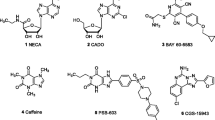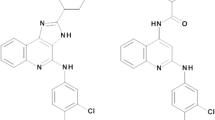Summary
The tritiated analogue of 2-chloro-N6-cyclopentyladenosine (CCPA), an adenosine derivative with subnanomolar affinity and a 10000-fold selectivity for A1 adenosine receptors, has been examined as a new agonist radioligand. [3H]CCPA was prepared with a specific radioactivity of 1.58 TBq/mmol (43 Ci/mmol) and bound in a reversible manner to A1 receptors from rat brain membranes with a high affinityK D-value of 0.2 nmol/l. In the presence of GTP aK D-value of 13 nmol/l was determined for the low affinity state for agonist binding. Competition of several adenosine receptor agonists and antagonists for [3H]CCPA binding to rat brain membranes confirmed binding to an A1 receptor. Solubilized A1 receptors bound [3H]CCPA with similar affinity for the high affinity state. At solubilized receptors a reduced association rate was observed in the presence of MgCl2, as has been shown for the agonist [3H]N6-phenylisopropyladenosine ([3H]PIA). [3H]CCPA was also used for detection of A1 receptors in rat cardio myocyte membranes, a tissue with a very low receptor density. A KD-value of 0.4 nmol/l and aB max-value of 16 fmol/ mg protein was determined in these membranes. In human platelet membranes no specific binding of [3H]CCPA was measured at concentrations up to 400 nmol/l, indicating that A2 receptors did not bind [3H]CCPA. Based on the subnanomolar affinity and the high selectivity for A1 receptors [3H]CCPA proved to be a useful agonist radioligand for characterization of A1 adenosine receptors also in tissues with very low receptor density.
Similar content being viewed by others
Abbreviations
- CHA:
-
N6-cyclopenyadenosine
- CPA:
-
N6-cy-clopentyladen,osine
- CCPA:
-
2-chloro-N6-cyclopentyladenosine
- CCCPA:
-
2-chloro-5′-chloro-5′-deoxy-N6-cyclopentyladenosine;
- CHAPS:
-
3-[3-(cholamidopropyl)dimethylammonio]-1-propanesulfonate
- DPCPX:
-
8-cyclopentyl-1,3-dipropylxanthine
- NECA:
-
N-ethylcarboxamidoadenosine
- PEI:
-
polyethylenimine
- PIA:
-
N6-phenylisopropyladenosine
References
Arend LJ, Burnatowska-Hledin MA, Spielman WS (1988) Adenosine receptor-mediated calcium mobilization in cortical collecting tubule cells. Am J Physiol 255:C 581-C 588
Bruns RF, Daly JW, Snyder SH (1980) Adenosine receptors in brain membranes: binding of N6-cyclohexyl[3H]adenosine and 1,3-diethyl-8[3H]phenylxanthine. Proc Natl Acad Sci [USA] 77: 5547–5551
Cristalli G, Grifantini M, Vittori S, Klotz K-N, Lohse MJ (1986) Synthesis of 2-azido-(R)-N6-p-hydroxyphenylisopropyladeno-sine (R-AHPIA) as a potential photoaffmity probe for AI adenosine receptors. Nucleos Nucleot 5:213–222
Cristalli G, Franchetti P, Grifantini M, Vittori S, Klotz K-N, Lohse MJ (1988) Adenosine receptor agonists: synthesis and biological evaluation of 1-deaza analogues of adenosine derivatives. J Med Chem 31:1179–1183
Gerlach E, Becker BF (eds) (1987) Topics and perspectives in adenosine research. Springer, Berlin Heidelberg New York Tokyo
Klotz K-N, Lohse MJ (1986) The glycoprotein nature of Al adenosine receptors. Biochem Biophys Res Commun 140:406–413
Klotz K-N, Cristalli G, Grifantini M, Vittori S, Lohse MJ (1985) Photoaffinity labeling of Al-adenosine receptors. J Biol Chem 260:14659–14663
Klotz K-N, Lohse MJ, Schwabe U (1986) Characterization of the solubilized A1 adenosine receptor from rat brain membranes. J Neurochem 46:1528–1534
Kurachi Y, Nakajiama T, Sugimoto T (1986) On the mechanism of activation of muscarinic K+ channels by adenosine in isolated atrial cells: involvement of GTP-binding proteins. Pflügers Arch 407:264–274
Kurtz A (1987) Adenosine stimulates guanylate cyclase activity in vascular smooth muscle cells. J Biol Chem 262:6296–6300
Linden J, Patel A, Sadek S (1985) [125I]Aminobenzyladenosine, a new radioligand with improved specific binding to adenosine receptors in the heart. Circ Res 56:279–284
Lohse MJ, Lenschow V, Schwabe U (1984) Two affinity states of R; adenosine receptors in brain membranes: analysis of guanine nucleotide and temperature effects on radioligand binding. Mol Pharmacol 26:1–9
Lohse MJ, Ukena D, Schwabe U (1985) Demonstration of R1 type adenosine receptors in bovine myocardium by radioligand binding. Naunyn-Schmiedeberg's Arch Pharmacol 328:310–316
Lohse MJ, Klotz K-N, Lindenborn-Fotinos J, Reddington M, Schwabe U, Olsson RA (1987) 8-Cyclopentyl-1,3-dipropylxanthine (DPCPX) — a selective high affinity antagonist radioligand for A1 adenosine receptors. Naunyn-Schmiedeberg's Arch Pharmacol 336:204–210
Lohse MJ, Klotz K-N, Schwabe U, Cristalli G, Vittori S, Grifantini M (1988a) 2-Chloro-N6-cyclopentyladenosine: a highly selective agonist at A1 adenosine receptors. Naunyn-Schmiedeberg's Arch Pharmacol 337:687–689
Lohse MJ, Elger B, Lindenborn-Fotinos J, Klotz K-N, Schwabe U (1988b) Separation of solubilized AZ adenosine receptors of human platelets from non-receptor [3H]NECA binding sites by gel filtration. Naunyn-Schmiedeberg's Arch Pharmacol 337: 64–68
Londos C, Cooper DMF, Wolff J (1980) Subclasses of external adenosine receptors. Proc Natl Acad Sci [USA] 77:2551–2554
Martens D, Lohse MJ, Rauch B, Schwabe U (1987) Pharmacological characterization of A1 adenosine receptors in isolated rat ventricular myocytes. Naunyn-Schmiedeberg's Arch Pharmacol 336:342–348
Moos WH, Szotek DS, Bruns RF (1985) N6-Cycloalkyladenosines. Potent, Al-selective adenosine agonists. J Med Chem 28:1383–1384
Schwabe U, Trost T (1980) Characterization of adenosine receptors in rat brain by (−)[3H]N6-phenylisopropyladenosine. Naunyn-Schmiedeberg's Arch Pharmacol 313:179–187
Taylor MD, Moos WH, Hamilton HW, Szotek DS, Patt WC, Badger EW, Bristol JA, Bruns RF, Heffner TG, Mertz TE (1986) Ribose-modified adenosine analogues as adenosine receptor agonist. J Med Chem 29:346–353
Trivedi BK, Bridges AJ, Patt WC, Priebe SR, Bruns RF (1989) N6-Bicycloalkyladenosines with unusually high potency and selectivity for the A1 adenosine receptor. J Med Chem 32:811
van Calker D, Müller M, Hamprecht B (1978) Adenosine inhibits the accumulation of cyclic AMP in cultured brain cells. Nature (Lond) 276:839–841
Williams M, Braunwalder A, Erickson TJ (1986) Evaluation of the binding of the A-1 selective adenosine radioligand cyclopentyladenosine (CPA), to rat brain tissue. Naunyn-Schmiedeberg's Arch Pharmacol 332:179–183
Author information
Authors and Affiliations
Additional information
Send offprint requests to K.-N. Klotz at the above address
Rights and permissions
About this article
Cite this article
Klotz, KN., Lohse, M.J., Schwabe, U. et al. 2-Chloro-N6-[3H]cyclopentyladenosine ([3HCCPA) —a high affinity agonist radioligand for A1 adenosine receptors. Naunyn-Schmiedeberg's Arch. Pharmacol. 340, 679–683 (1989). https://doi.org/10.1007/BF00717744
Received:
Accepted:
Issue Date:
DOI: https://doi.org/10.1007/BF00717744




